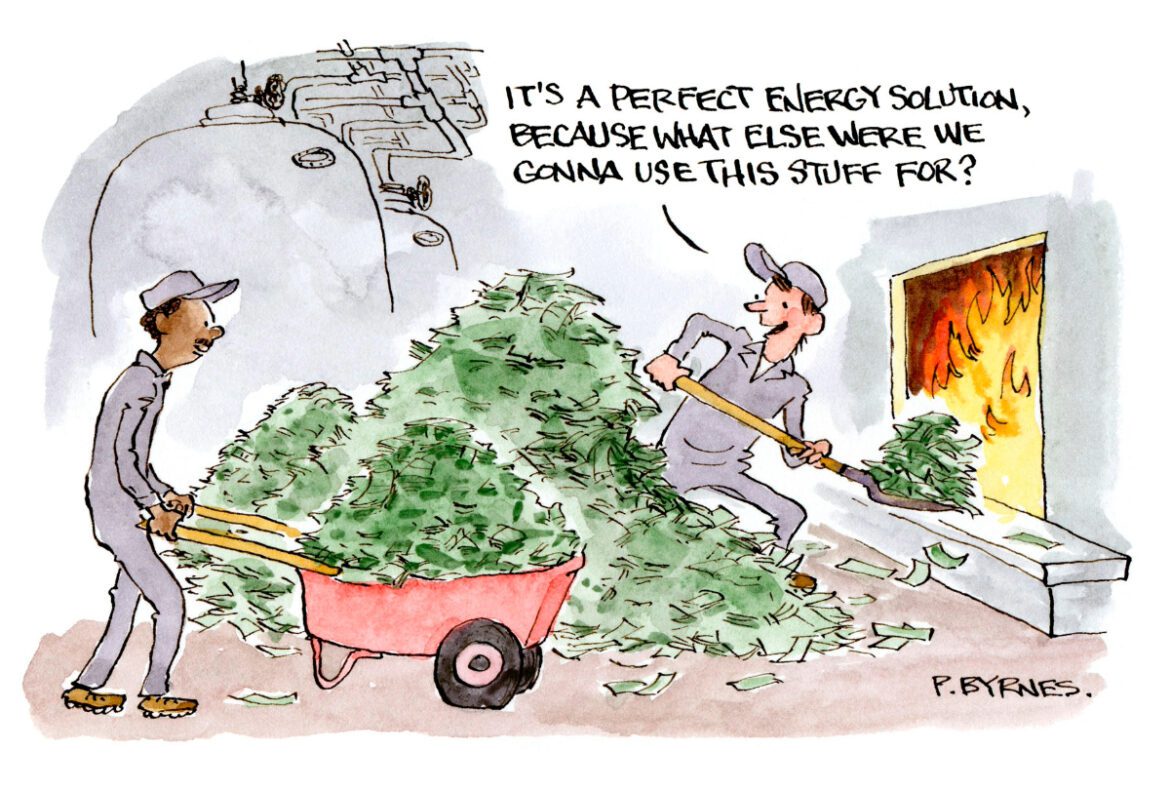
Artwork by Pat Byrnes
At this year’s COP28 United Nations Climate Change Conference, 22 countries pledged to triple their nuclear capacity, purportedly in the name of a clean energy future. What they should really be saying is they’d like to waste astronomical sums on a technology that has had its heyday in the 1970s, as the World Nuclear Industry Status Report has been confirming for decades.
The scientists at Project Drawdown have spent years calculating how we can decarbonize the economy most cost-effectively. If what the passionate nuclear adherents believe were true, nuclear power would have to be at least among the top ten in the list of climate solutions. It’s not even in the top 50. Even MIT’s EnRoads Simulator, not known to be run by anti-nuclear agitators, does not suggest that expanding nuclear energy would be the panacea people seem to wish it to be. In their calculation, 100% investment in renewables would have double the impact of 100% investment in nuclear. That should at least raise eyebrows.
Americans of all ages show a strangely passionate allegiance to nuclear technology. All they want to talk about is how the atom will save the day. Clearly, nuclear PR guys can pat each other on the back. Their lobbying efforts have succeeded in convincing “a growing share of Americans” of the supposed benefits of nuclear power. And that at a time when the Bulletin of Atomic Scientists’ “Doomsday Clock” is set to 90 seconds to midnight – “the closest to atomic catastrophe it has ever been, in part because nuclear power plants in Ukraine are repeatedly coming under fire, not to mention the threat of nuclear war. But nobody is paying much attention to the threat of nuclear catastrophe.
The US is home to 93 active nuclear power plants, the largest number of any country in the world, the majority of them in the Eastern half. Almost all are over 30 years old, six are over 50 years old, and investments in new ones keep getting rejected for obvious reasons: It makes no financial sense. Yet, nuclear energy seems to have become everyone’s favorite solution to the climate crisis, starting with Jim Hansen and Bill Gates. Unless, of course, you take into account the people in places that have been devastated by nuclear testing or nuclear accidents, including many native American tribes whose communities continue to fight for their rights.
Children and pregnant women are especially vulnerable to radiation, as a recent study suggests. But even if you could care less about those who suffer from cancer as a result of radiation poisoning, the astronomical costs of nuclear power should at least give everyone pause.
Some suggest that costs vary according to the country where nuclear power plants are built. But you could not power any city in the US with a nuclear plant that’s sitting in Russia or China. And you’d hope there is agreement that cutting costs on anything involving radioactive material isn’t such a great idea. There is also no question that coal is more devastating for the climate, but shutting down coal is a lot easier than shutting down a nuclear plant.
Germans of my generation remember vividly what happened after the catastrophic accident in Chernobyl in 1986 – even several thousand miles away. How the police rushed to German farmer’s markets to pull fresh vegetables from the tables. How we were not allowed to eat the rhubarb from our garden or collect mushrooms in the forest for years. Decades later, radioactive contamination from Chernobyl is still found in 95% of samples. US military sites are no different. The Hanford Nuclear Reservation where materials for the bombing of Nagasaki were generated is now one of the most contaminated nuclear waste sites in the Western Hemisphere. According to NOAA, the site accounts for two-thirds of all the high-level radioactive waste in the entire country.
When Japanese authorities decided to begin releasing some 350 million gallons of stored radioactive water into the ocean earlier this year, it did not cause an outcry. But it should have. Collected over the 12 years since a tsunami caused a nuclear disaster at the Fukushima Daiichi plant in 2011, it was widely reported that scientists agree releasing the water was safe. At least if everything is done according to plan. But it’s not only about whether or not over a thousand tons of water can be filtered safely over several decades. It’s also about the fact that twelve years after the disaster this nuclear power plant is still causing huge headaches and huge costs, which surpassed a trillion dollars years ago. Cleaning up the radioactive mess at the “defunct” reactor is still ongoing. It was no different in Chernobyl.
Wonder what Project Drawdown lists as the most cost-effective measures to address climate change? It’s reducing food waste and a plant-based diet. Sounds a lot more sensible than adding radioactive waste to a planet threatened by extreme weather.

